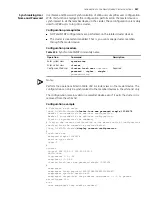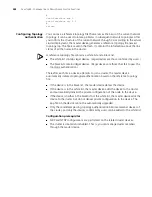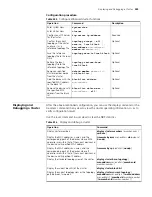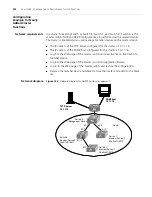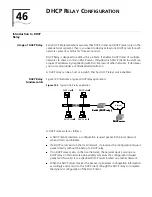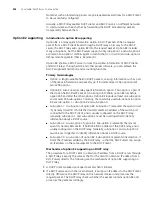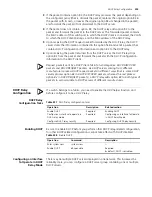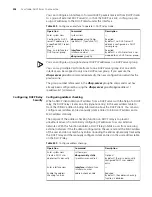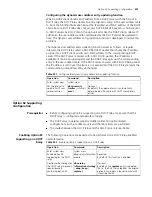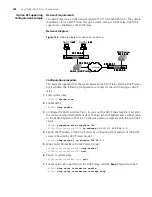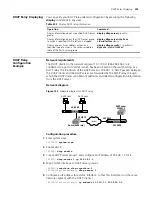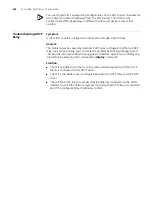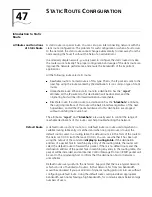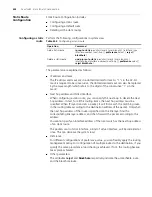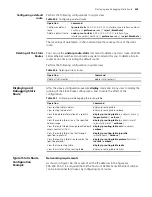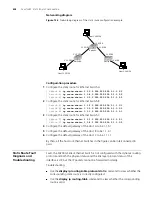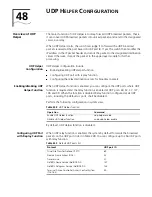
47
S
TATIC
R
OUTE
C
ONFIGURATION
Introduction to Static
Route
Attributes and Functions
of Static Route
A static route is a special route. You can set up an interconnecting network with the
static route configuration. The problem for such configuration is when a fault occurs
to the network, the static route cannot change automatically to steer away from the
node causing the fault, if without the help of an administrator.
In a relatively simple network, you only need to configure the static routes to make
the router work normally. The proper configuration and usage of the static route can
improve the network performance and ensure the bandwidth of the important
applications.
All the following routes are static routes:
■
Reachable route: A normal route is of this type. That is, the IP packet is sent to the
next hop using the route marked by the destination. It is a common type of static
routes.
■
Unreachable route: When a static route to a destination has the “
reject
”
attribute, all the IP packets to this destination will be discarded, and the
originating host will be informed destination unreachable.
■
Blackhole route: If a static route to a destination has the “
blackhole
” attribute,
the outgoing interface of this route is the Null 0 interface regardless of the next
hop address, and all the IP packet addressed to this destination are dropped
without notifying the source host.
The attributes “
reject
” and “
blackhole
” are usually used to control the range of
reachable destinations of this router, and help troubleshooting the network.
Default Route
A default route is a static route, too. A default route is a route used only when no
suitable routing table entry is matched and when no proper route is found, the
default route is used. In a routing table, the default route is in the form of the route to
the network 0.0.0.0 (with the mask 0.0.0.0). You can see whether it has been set
using the output of the command
display ip routing-table
. If the destination
address of a packet fails in matching any entry of the routing table, the router will
select the default route to forward this packet. If there is no default route and the
destination address of the packet fails in matching any entry in the routing table, this
packet will be discarded, and an Internet Control Message Protocol (ICMP) packet will
be sent to the originating host to inform that the destination host or network is
unreachable.
Default route is very useful in the networks. Suppose that there is a typical network,
which consists of hundreds of routers. In that network, far from less bandwidth
would be consumed if you put all kinds of dynamic routing protocols into use without
configuring a default route. Using the default route could provide an appropriate
bandwidth, even not achieving a high bandwidth, for communications between large
numbers of users.
Summary of Contents for 4200G 12-Port
Page 10: ...8 CONTENTS...
Page 14: ...4 ABOUT THIS GUIDE...
Page 46: ...32 CHAPTER 5 LOGGING IN THROUGH WEB BASED NETWORK MANAGEMENT SYSTEM...
Page 48: ...34 CHAPTER 6 LOGGING IN THROUGH NMS...
Page 60: ...46 CHAPTER 9 VLAN CONFIGURATION...
Page 64: ...50 CHAPTER 10 MANAGEMENT VLAN CONFIGURATION...
Page 80: ...66 CHAPTER 13 GVRP CONFIGURATION...
Page 98: ...84 CHAPTER 15 LINK AGGREGATION CONFIGURATION...
Page 112: ...98 CHAPTER 18 MAC ADDRESS TABLE MANAGEMENT...
Page 126: ...112 CHAPTER 19 LOGGING IN THROUGH TELNET...
Page 162: ...148 CHAPTER 20 MSTP CONFIGURATION...
Page 274: ...260 CHAPTER 29 IGMP SNOOPING CONFIGURATION...
Page 276: ...262 CHAPTER 30 ROUTING PORT JOIN TO MULTICAST GROUP CONFIGURATION...
Page 298: ...284 CHAPTER 33 SNMP CONFIGURATION...
Page 304: ...290 CHAPTER 34 RMON CONFIGURATION...
Page 338: ...324 CHAPTER 36 SSH TERMINAL SERVICES...
Page 356: ...342 CHAPTER 38 FTP AND TFTP CONFIGURATION...
Page 365: ...Information Center Configuration Example 351 S4200G terminal logging...
Page 366: ...352 CHAPTER 39 INFORMATION CENTER...
Page 378: ...364 CHAPTER 40 BOOTROM AND HOST SOFTWARE LOADING...
Page 384: ...370 CHAPTER 41 Basic System Configuration and Debugging...
Page 388: ...374 CHAPTER 43 NETWORK CONNECTIVITY TEST...
Page 406: ...392 CHAPTER 45 CONFIGURATION OF NEWLY ADDED CLUSTER FUNCTIONS...

